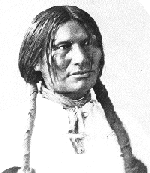

As the leader of the Miniconjou band massacred at Wounded Knee Creek on December 29, 1890, Big Foot haunts the history of the American West.
Big Foot and his people lived on the Cheyenne River Reservation in South Dakota, and were among the most enthusiastic believers in the Ghost Dance ceremony when it arrived among the Lakota in the spring of 1890. The hunger and misery that had followed the final break-up of their great reservation in 1889 made the Lakota keenly receptive to the Ghost Dance message of messianic renewal, and the movement swept rapidly through their encampments (causing local Indian Agents to react with alarm).
At the Standing Rock reservation (where Sitting Bull was suspected of encouraging the Ghost Dance) the crisis led to bloodshed when Indian police sent to arrest the aging holy many killed him in a confrontation with his followers. Fearful of reprisals, many from Sitting Bull's band fled south where they found a haven with Big Foot.
Big Foot decided to lead his people away from the possibility of further violence at neighboring Standing Rock, and headed farther south toward the reservation at Pine Ridge (hoping to find safety there). Increasingly ill with pneumonia, he had no intention of fighting and was flying a white flag when soldiers patrolling for roving bands caught up with him on December 28, 1890. That night Big Foot and his people camped near Wounded Knee Creek, surrounded on all sides by soldiers.
The next morning, the soldiers set up several large Hotchkiss guns on a hill overlooking the camp and began confiscating the Indian's weapons. When a gun was discharged, they opened fire, and within a few minutes many were dead (see our story on Wounded Knee).
Big Foot himself was among the first killed. His frozen corpse, half raised as though trying to warn his people of their imminent disaster, lay untouched for three days until it was unceremoniously dumped into a mass grave.
